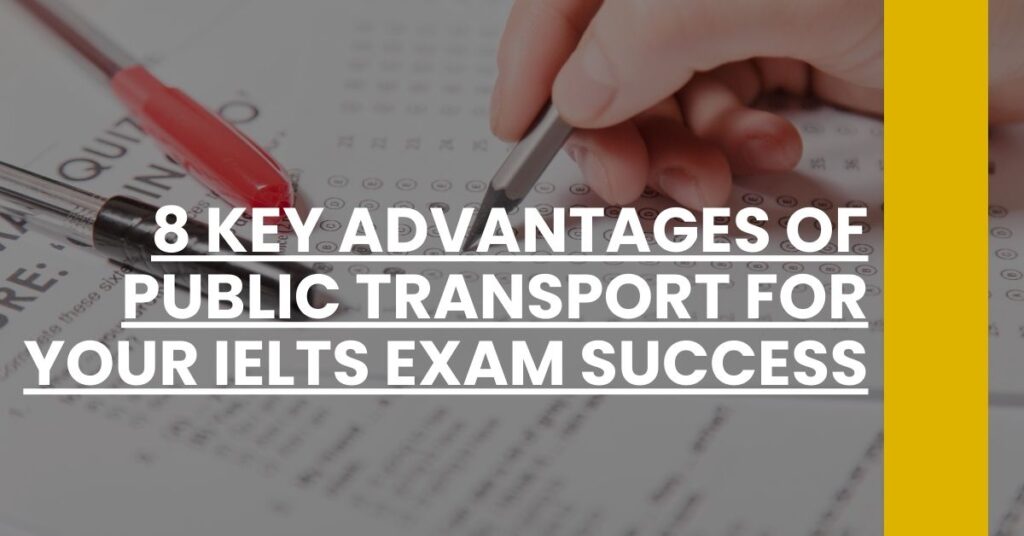Commuting using public transport offers several advantages that can positively impact your IELTS exam preparation. It is important to not only understand what these advantages are, but also the reasons behind them.
One of the key benefits of using public transport is its contribution to sustainability. Public transport systems, such as buses, trains, and trams, are generally more energy efficient and produce fewer greenhouse gas emissions compared to private vehicles. By choosing public transport, you are actively reducing your carbon footprint and helping to mitigate climate change. This topic is often discussed in the IELTS exam, particularly in the context of environmental issues and sustainable development.
Another advantage of public transport is its role in promoting social equity. Public transportation networks are designed to serve a wide range of people, regardless of their socioeconomic background. They provide affordable and accessible transportation options for individuals who may not have access to private vehicles. This aspect of public transport is often highlighted in IELTS questions related to social equality and transportation infrastructure.
In addition to sustainability and social equity, public transport also offers convenience and cost savings. Using public transport can save you money on fuel, parking fees, and vehicle maintenance costs. It also allows you to avoid traffic congestion and the stress associated with driving in busy urban areas. These benefits can be discussed in IELTS questions related to personal finance, urban planning, and quality of life.
By understanding the advantages of public transport and the reasons behind them, you will be better equipped to provide well-rounded and insightful answers in the IELTS exam. So, next time you consider your commute, remember the impact it can have on your IELTS preparation and choose public transport to reap its benefits.
- 1. Cost-Effectiveness
- 2. Environmental Impact
- 3. Reduces Traffic Congestion
- 4. Promotes Social Equity
- 5. Increases Safety
- 6. Encourages Healthy Lifestyles
- 7. Convenience and Accessibility
- 8. Improves Urban Planning
- IELTS Writing and Speaking Test Benefits
- Public Transportation Vocabulary Enhancement
- Conclusion: Leveraging Public Transport Knowledge in IELTS
1. Cost-Effectiveness
If you’re searching for the advantages of public transport IELTS, you’ll quickly find that cost-effectiveness tops the list. Whether you’re a student managing a tight budget or a working professional aiming to reduce your daily expenses, public transportation presents a smart financial choice. Let’s break down why choosing the bus or train over a gas-guzzling car could be your ticket to more savings:
- Significant Savings: It’s a staggering fact — opting for public transport can tuck away an average of $9,797 per year into your pocket in the U.S. No small change, right?
- Cut Hidden Costs: While the price at the pump is obvious, parking fees, insurance, and maintenance add up stealthily behind the scenes. On the other hand, a monthly transit pass’ price is far more predictable and gentle on your wallet.
- Fuel for Thought: With every mile traveled, public transport uses considerably less fuel per passenger than private vehicles. As fuel prices oscillate, your budget remains unaffected aboard the public transport train.
By choosing buses and trains, you’re not just cutting costs; you’re investing in a more sustainable financial future. Who knew climbing aboard public transit was like signing up for a savings plan?
2. Environmental Impact
For all you IELTS aspirants articulating the advantages of public transport, consider the profound environmental impact your travel choices can have. Public transportation is not just a journey from A to B; it’s a journey towards a greener future.
- Cleaner Air: By sharing your ride with the community, you help reduce harmful CO2 emissions. It’s been proven that public transport can trim down the city’s carbon footprint, making each trip a small victory for planet Earth.
- Quieter Streets: Less traffic hum means a more tranquil urban soundscape. Who wouldn’t welcome a break from the roar of heavy traffic?
- Reduced Sprawl: Public transport supports compact city growth, as it lessens the need for sprawling road networks. With fewer roads, we welcome more trees and green spaces into our lives.
With every tap of your transit card, consider yourself an active participant in steering us all towards a more sustainable future.
3. Reduces Traffic Congestion
Imagine a world where rush hour doesn’t spell out a nightmare of honking cars and snail-paced movement. This is the world public transportation advocates for — fluid, efficient, and uncluttered.
Public transport services reduce traffic congestion by offering a viable alternative to the car-dependent lifestyle. Here’s how you, as a public transport advocate, can chip away at the city’s traffic woes:
- Maximize Space: Each bus equals approximately 30 cars off the road. Imagine the freed-up space!
- Boost Productivity: With fewer cars, there’s less traffic — making for smoother, quicker commutes for everyone, boosting city productivity.
Embrace the role of public transportation in tackling urban traffic jams and let your IELTS essay highlight the value of shared commutes.
4. Promotes Social Equity
Discussing the advantages of public transport IELTS, we delve beyond the surface into the social strata it impacts. The ripples created by a bus line or train route extend into the realm of social equity, granting mobility freedoms to all layers of society.
- Universal Accessibility: From the working-class hero to the job-seeking youth, public transport extends its reach indiscriminately.
- A Bridge Over Troubled Economic Waters: This collective travel mode often proves a lifeline for low-income individuals, safeguarding their access to educational and employment opportunities normally beyond reach.
By underpinning equitable opportunities, public transport is much more than a mere convenience — it stands as a social leveler. The principle is straightforward: mobility should not be a privilege but a right, as this improvement in urban public transportation systems demonstrates.
5. Increases Safety
Aspiring IELTS scholars, when pondering the advantages of public transport IELTS, should not overlook the safety public transit inherently delivers. Your chance of encountering an accident on the road lessens significantly when you step aboard a bus or train — why?
- Professional Operation: Buses and trains are manned by seasoned professionals, trained to navigate the bustling streets with eyes keen on safety.
- Regulated Standards: Public transport is held to stringent safety standards. Regulation ensures each journey aligns with top-tier safety protocols.
In the grand spectrum of travel, public transport emerges as a beacon of security. Foregoing the wheel means you’re part of a system where safety comes first, a reassurance that could be a vital piece of your next IELTS response.
6. Encourages Healthy Lifestyles
When it comes to discussing the advantages of public transport IELTS style, let’s not bypass the healthy kick it endows on your lifestyle. You might not equate your daily commute with your fitness regimen, but public transport inadvertently nudges you towards a more active existence:
- Stepping Up the Game: A jaunt to the bus stop or the train station invariably adds a few hundred steps to your daily count. Before you know it, you’re meeting health benchmarks without stepping foot in a gym.
- Cycle of Benefits: Many public systems are integrating bike-share programs, allowing for a seamless intermodal transportation experience that elevates your heart rate and environmental conscience all at once.
- Stress Relief: Abandon the driver’s seat and the chaotic road dance. With less stress from navigating the traffic, your mental well-being stands to win as well.
By weaving movement into the very fabric of your commute, public transport doesn’t just take you places—it takes your health forward too. Revel in this perk and watch as your fitness tracker congratulates you on unexpectedly exceeding your daily goal.
7. Convenience and Accessibility
The convenience and accessibility of public transport cannot be sidelined while delving into its advantages. IELTS candidates will find that exploring these aspects can be integral to acing the exam, much like how seamless connectivity is integral to urban living:
- Network of Possibilities: An array of routes spider-webbing the city means you can get virtually anywhere with just a swipe of a card.
- Inclusivity in Motion: Strives in technology have ushered in low-floor vehicles, visual and audio stop announcements, and tactile pads—forging a friendlier experience for all commuters.
- Time Management: With apps and real-time updates, you can align your schedule harmoniously with transit timings, turning wait time into your time.
Embrace the role of modern transport systems in bettering urban living and how it makes city navigation a breeze for everyone, whether it’s a daily grind or a rendezvous across town.
8. Improves Urban Planning
Urban planning and public transport are in a symbiotic relationship—each influencing the development of the other. In your advantages of public transport IELTS argument, respect the impact it has on the shaping of our cities:
- Spatial Efficiency: Integrated transport hubs encourage optimal use of land, beckoning city dwellers into denser, more vibrant communities.
- Economic Attractiveness: With a robust transit system in place, cities attract businesses and talent, powering the local economy.
- Quality of Life: Public transport lays the groundwork for cities that prioritize green spaces, cultural sites, and pedestrian zones over never-ending asphalt.
Knowing how public transit investments lead to smarter, more livable urban landscapes will not only score you points on the IELTS but also in understanding the future of city living.
IELTS Writing and Speaking Test Benefits
Now, let’s pivot towards how discussing the advantages of public transport equips you for IELTS success. Your Writing and Speaking tasks beckon for well-rounded answers, and a thorough understanding of public transport’s benefits enriches your content:
- Band Score Boosters: Topical knowledge leads to confident delivery and substantiated arguments, and that’s music to an examiner’s ears.
- Idea Development: Illustrating points with public transport examples demonstrates critical thinking and the ability to discuss issues from multiple angles.
- Lexical Resource Enhancement: The topic is a treasure trove of transport-specific vocabulary, serving as a golden opportunity to display language diversity.
In the realm of IELTS, where articulation is king, knowing the ins and outs of public transport gives you a chessboard advantage.
Public Transportation Vocabulary Enhancement
To the keen IELTS learner, public transport isn’t just about getting to places—it’s about transporting your vocabulary to new heights. Here’s an invitation to embrace terminologies that could make your examiner nod in approval:
- Descriptive Journeys: Words like “intermodal,” “commuter,” and “congestion” paint vivid pictures of your thoughts.
- Action Words: Verbs like “navigate,” “access,” and “connect” lend a dynamic edge to your language.
- Adjectives and Adverbs: “Efficient,” “economical,” and “reliably” are just a few gems that could add sparkle to your discourse.
Enriching your language arsenal with well-chosen words reflects an invested and informed candidate—one who’s ready to take on the IELTS challenge with aplomb.
Conclusion: Leveraging Public Transport Knowledge in IELTS
In conclusion, understanding the advantages of public transport is more than a lesson in civic awareness—it’s a strategic maneuver in your IELTS readiness playbook. As you dissect the financial, environmental, social, and urban planning merits transport systems offer, you construct a sturdy foundation for your exam responses.
As you integrate this knowledge into your IELTS preparation, appreciate its broader implications. Public transport discussions reflect global trends and societal shifts, topics that are increasingly relevant in today’s interconnected world. Carry this insight proudly into your IELTS examination and beyond—it’s not only a triumph in test-taking but also a step towards global citizenship.
Explore the advantages of public transport for IELTS success: Save money, reduce pollution, and improve urban living.

